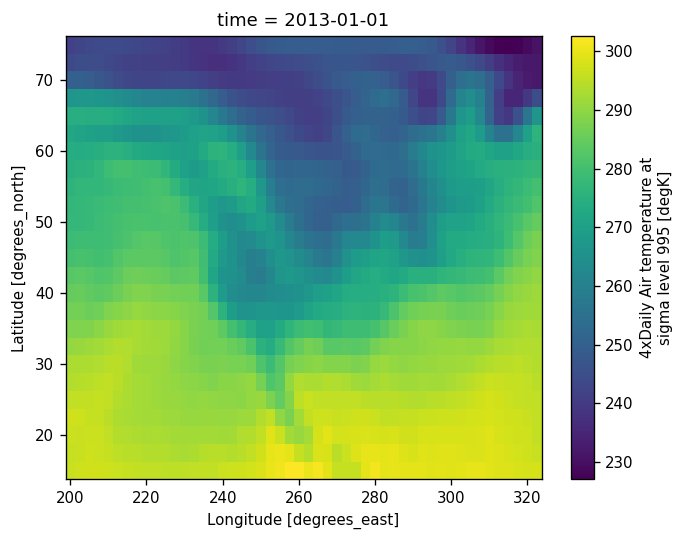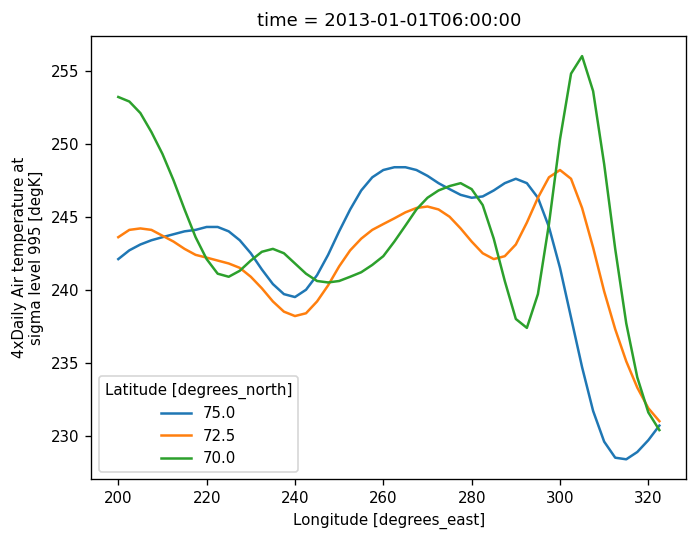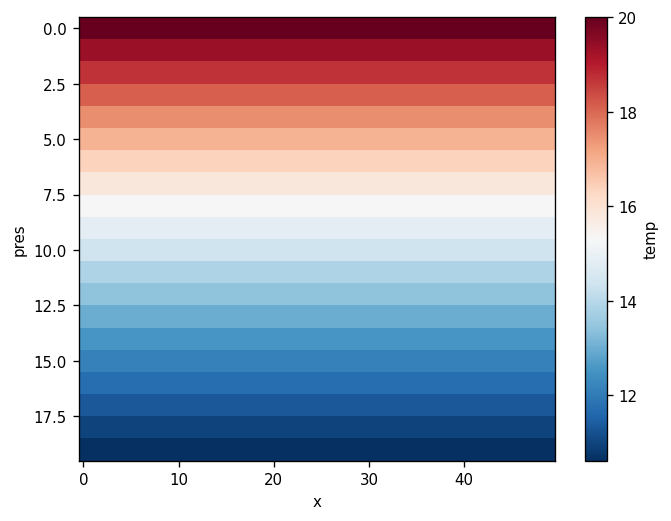Plotting#
Plotting is where cf_xarray really shines in our biased opinion.
from cf_xarray.datasets import airds
air = airds.air
air.cf
Coordinates:
CF Axes: * X: ['lon']
* Y: ['lat']
* T: ['time']
Z: n/a
CF Coordinates: * longitude: ['lon']
* latitude: ['lat']
* time: ['time']
vertical: n/a
Cell Measures: area: ['cell_area']
volume: n/a
Standard Names: * latitude: ['lat']
* longitude: ['lon']
* time: ['time']
Bounds: n/a
Grid Mappings: n/a
Tip
Only DataArray.plot is currently supported.
Using CF standard names#
Note the use of "latitude" and "longitude" (or "X" and "Y") in the following as a “standard” substitute for the dataset-specific "lat" and "lon" variables.
air.isel(time=0).cf.plot(x="X", y="Y")
<matplotlib.collections.QuadMesh at 0x7fb849a79720>

air.cf.isel(T=1, Y=[0, 1, 2]).cf.plot(x="longitude", hue="latitude")
[<matplotlib.lines.Line2D at 0x7fb8419fc070>,
<matplotlib.lines.Line2D at 0x7fb8419fc0a0>,
<matplotlib.lines.Line2D at 0x7fb8419fc1c0>]

air.cf.plot(x="longitude", y="latitude", col="T")
<xarray.plot.facetgrid.FacetGrid at 0x7fb881442920>

Automatic axis placement#
Now let’s create a fake dataset representing a (x,z) cross-section of the ocean. The vertical coordinate here is “pressure” which increases downwards.
We follow CF conventions and mark pres as axis: Z, positive: "down" to indicate these characeristics.
import matplotlib as mpl
import numpy as np
import xarray as xr
ds = xr.Dataset(
coords={
"pres": ("pres", np.arange(20), {"axis": "Z", "positive": "down"}),
"x": ("x", np.arange(50), {"axis": "X"})
}
)
ds["temp"] = 20 * xr.ones_like(ds.x) * np.exp(- ds.pres / 30)
ds.temp.cf
Coordinates:
CF Axes: * X: ['x']
* Z: ['pres']
Y, T: n/a
CF Coordinates: * vertical: ['pres']
longitude, latitude, time: n/a
Cell Measures: area, volume: n/a
Standard Names: n/a
Bounds: n/a
Grid Mappings: n/a
The default xarray plot has some deficiencies
ds.temp.plot(cmap=mpl.cm.RdBu_r)
<matplotlib.collections.QuadMesh at 0x7fb8406adf30>

cf_xarray can interpret attributes to make two decisions:
That
presshould be the Y-AxisSince
presincreases downwards (positive: "down"), the axis should be reversed so that low pressure is at the top of the plot. Now we have a more physically meaningful figure where warmer water is at the top of the water column!
ds.temp.cf.plot(cmap=mpl.cm.RdBu_r)
<matplotlib.collections.QuadMesh at 0x7fb8407c7b50>
